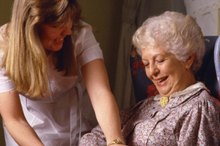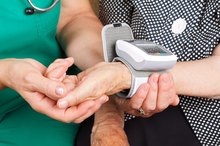How to Write a Nutrition Care Plan
Learning how to write a succinct, patient-focused nutrition care plan is a big step for nursing and dietary professionals alike. Care planning is completed by registered nurses and dietitians who strive to help patients rectify nutritionally impacted diseases or complaints. These nutrition care plans act as a road map to wellness and incorporate physical, spiritual and mental attributes of each individual patient. Unlike medical diagnosis, given only by physicians, nutrition care plans and diagnosis reflect the patient's underlying nature and can be cured with intervention.
Assess the patient. Cephalocaudal, or head to toe assessments, are a skill of trade learned in dietitian or nursing school. Look and listen for signs of nutritional imbalances. Something as simple as an off-handed statement by a patient, such as "I can't stand how fat I look" can open up an entire conversation and give insight into her home nutrition habits.
- Learning how to write a succinct, patient-focused nutrition care plan is a big step for nursing and dietary professionals alike.
- Unlike medical diagnosis, given only by physicians, nutrition care plans and diagnosis reflect the patient's underlying nature and can be cured with intervention.
Difference Between RN & LPN Assessment
Learn More
Use any tools available, such as nutrition questionnaires or health inquiry forms. These simple sheets may open up further avenues of questioning or conversation based on each individual's background. This is also a good time to ascertain the patient's preferred learning method -- casual by conversation or audiovisual by hand-outs and videos.
Review the patient's medical chart. Look at her primary medical diagnosis, lab values and hemodynamics, such as blood pressure and heart rate, and her height to weight ratio. Consider other tests that may have been completed, such as a urinalysis, which could demonstrate protein overflow in the urine and a potential metabolic disorder to be addressed.
Nursing Care Plans and Nutrition
Learn More
Take the patient's cultural and religious background into consideration while formulating a care plan. Some religions may encourage periods of fasting or limitation of certain foods, such as meat in Catholicism during Lent. An individualized nutrition care plan will include these considerations for each patient.
- Use any tools available, such as nutrition questionnaires or health inquiry forms.
- Consider other tests that may have been completed, such as a urinalysis, which could demonstrate protein overflow in the urine and a potential metabolic disorder to be addressed.
Develop a nutrition diagnosis using nursing diagnosis or dietitian diagnosis terminology based on the professional writing the care plan. The nutritional diagnosis should be concise, based on assessment-gathered data and allows one diagnostic statement per problem. Each nutrition care plan may have one or several nutritional diagnostic statements dependent on the complexity of each patient.
Create the most essential part of the diagnostic statement for the care plan -- the diagnosis. This will include a preceding adverb describing the potential or actuality of the condition isolated such as at-risk for, chronic or acute. For instance, someone who is recently injured and bed-bound may have a diagnosis reading: "At-risk for weight gain related to sports injury."
Support the diagnosis by finishing the diagnostic sentence with the signs and symptoms supporting the diagnosis -- referred to as the etiology of the problem and written "as evidenced by." For the above example, the complete diagnostic sentence would read: "At risk for weight gain related to sports injury as evidenced by weight gain of 10 pounds in two weeks."
- Develop a nutrition diagnosis using nursing diagnosis or dietitian diagnosis terminology based on the professional writing the care plan.
- Support the diagnosis by finishing the diagnostic sentence with the signs and symptoms supporting the diagnosis -- referred to as the etiology of the problem and written "as evidenced by."
Finish the care plan by detailing the plan for intervention, monitoring and period prior to re-evaluating the patient's status. For the bed-bound sports injury patient, interventions may include obtaining daily weights, providing education on caloric balance and nutrition choices as well as incorporating physical therapy assistance to motivate and help the patient get out of bed again. Goal statements conclude a nutrition care plan and could include: "Patient will be able to verbalize understanding of decreased caloric requirements while bed bound" or "Patient will not gain further weight while immobilized for four weeks".
Tips
The diagnostic language varies by profession. Refer to your professional standard language before writing the care plan. Care plans are considered living documents; they change as the patient changes and learns. Update them frequently to keep them relevant.
Related Articles
References
Writer Bio
As a bachelor's-prepared registered nurse with more than 15 years of diversified experience, Juliet Wilkinson innerves our health-conscious population through expert articles. She is a motivated professional who believes that preventive care is the first step towards health and well-being.









